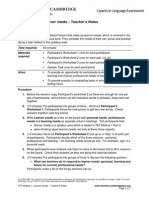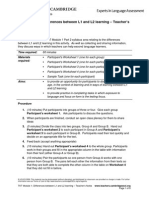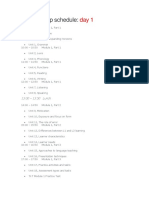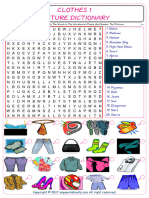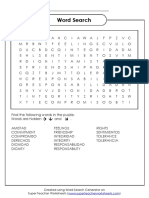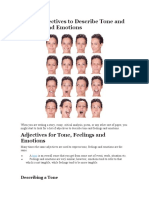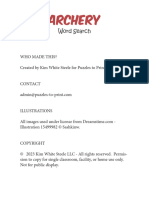TKT Module 2 Using Teaching Aids
TKT Module 2 Using Teaching Aids
Uploaded by
Sonia Campbell HamiltonCopyright:
Available Formats
TKT Module 2 Using Teaching Aids
TKT Module 2 Using Teaching Aids
Uploaded by
Sonia Campbell HamiltonOriginal Description:
Original Title
Copyright
Available Formats
Share this document
Did you find this document useful?
Is this content inappropriate?
Copyright:
Available Formats
TKT Module 2 Using Teaching Aids
TKT Module 2 Using Teaching Aids
Uploaded by
Sonia Campbell HamiltonCopyright:
Available Formats
TKT Module 2: Selection and use of teaching aids Teachers
Notes
Description
Teachers discuss different teaching aids and the uses teaching aids can be put to. They also
discuss their experiences of using teaching aids, and how they could improve on this. The
selection and use of teaching aids is one of the syllabus areas in TKT Module 2 Part 2.
Time required:
55 minutes
Materials
required:
Participants Worksheet 1 (one for each pair)
Participants Worksheet 2 (one for each participant)
Sample Task (one for each participant)
To introduce types of teaching aids and to discuss their teaching
functions
To provide practice in completing tasks in which the selection and
use of teaching aids
Aims:
Procedure
1. (10 minutes) On the board, write: Teaching aids. Elicit what they are (equipment
and resources that teachers use in the classroom).
2. Hand out Participants worksheet 1. In pairs, participants find the ten aids in the
wordsearch activity. Allow five minutes for this. If participants are finding it difficult to
find the words, you can give them some of the words, or give clues.
3. Check answers together (see key below). Tell participants that the selection and use
of teaching aids is a syllabus area tested in TKT Module 2 Part 2 and that the words
in the wordsearch activity were taken from the TKT Glossary. Ask participants to add
any other ideas to the list of 10 (e.g. computer, cassette/CD player, DVD player,
phonemic chart).
4. (15 minutes) Hand out Participants worksheet 2. Participants work in groups of
three and decide which teaching aids they would use to achieve the aims in the
lessons listed 110 on the worksheet. Check answers together (see key below).
5. (10 minutes) Still in groups of 3, participants discuss the following:
Tell each other about what aid you last used in class, how it helped the
lesson and whether you would use it in the same way if you taught the same
lesson again.
Feed back with the whole group for participants to share ideas.
6. (10 minutes) Give out Sample Task. Ask participants to complete the sample task
on their own then compare their answers with a partner. Check answers together
(see key below).
UCLES 2009. This material may be photocopied (without alteration) and distributed for classroom use provided no charge is made. For further
information see our Terms of Use at http://www.teachers.cambridgeESOL.org/ts/legalinfo
TKT Module 2: Selection and use of teaching aids Teachers Notes
www.teachers.cambridgeesol.org
Page 1 of 6
7. (5 minutes) Round up to summarise points covered. Ask participants:
What is the TKT Module 2 syllabus area for this session? (the selection and
use of teaching aids)
What do you think are the main reasons for using teaching aids? (allow
participants to share views)
How can participants prepare for this section of the test? (review the section
in the TKT Glossary which lists teaching aids).
UCLES 2009. This material may be photocopied (without alteration) and distributed for classroom use provided no charge is made. For further
information see our Terms of Use at http://www.teachers.cambridgeESOL.org/ts/legalinfo
TKT Module 2: Selection and use of teaching aids Teachers Notes
www.teachers.cambridgeesol.org
Page 2 of 6
TKT Module 2: Selection and use of teaching aids Answer Keys
Key to Participants Worksheet 1
Blackboard, whiteboard, flashcards, OHP, DVD, CDs, puppets, charts, realia, posters
F
(initial letters of words in bold; letters used by 2 words in dark grey)
Key to Participants Worksheet 2
1. blank paper
2. flash cards with pictures, realia
3. DVD
4. phonemic chart, flashcards
5. posters, whiteboard, OHP
6. pictures, posters
7. whiteboard, computer, OHP
8. DVD, CD player, puppets
9. flash cards with pictures, realia, computer, OHP
10. blank paper, posters, whiteboard
Key to Sample Task
1. C
2. E
3. F
4. B
5. A
6. D
UCLES 2009. This material may be photocopied (without alteration) and distributed for classroom use provided no charge is made. For further
information see our Terms of Use at http://www.teachers.cambridgeESOL.org/ts/legalinfo
TKT Module 2: Selection and use of teaching aids Answer Keys
www.teachers.cambridgeesol.org
Page 3 of 6
TKT Module 2: Selection and use of teaching aids Participants
Worksheet 1
WORDSEARCH
Can you find ten teaching aids?
A S H C A R D S
D R A O B K C A
W H
S
E B O A R D
T R A H C P D X R
D K N O R M V H M E
C G A X H D
L Q P U P P E
S E R T
D
E O A
S
S O P M L
E C A
Z W A
UCLES 2009. This material may be photocopied (without alteration) and distributed for classroom use provided no charge is made. For further
information see our Terms of Use at http://www.teachers.cambridgeESOL.org/ts/legalinfo
TKT Module 2: Selection and use of teaching aids Participants Worksheet 1
www.teachers.cambridgeesol.org
Page 4 of 6
TKT Module 2: Selection and use of teaching aids Participants
Worksheet 2
Work with a partner and decide which teaching aids you would use to achieve the
teaching aims numbered 110. There may be more than one possible answer.
whiteboard
OHP
DVD player
puppets
flashcards
realia
phonemic chart
CD player
computer
posters
blank paper
1. to get students to build a paper aeroplane by following written instructions
2. to teach 10 words related to furniture: table, chair, bed, desk, sofa, bookcase, stool,
shelves
3. to get students to realise how important body language is in giving a business
presentation
4. to help students pronounce 3 problem sounds by using minimal pair work
5. to give students an opportunity to generate and organise ideas for a composition
6. to help students to design a poster in groups showing what they did during their last
holidays
7. to focus on accuracy in writing by showing students an example of writing and asking
them to correct it
8. to teach students expressions for introducing themselves to other people and responding
to introductions
9. to help students revise new vocabulary from 5 different lexical sets
10. to get students to plan a class picnic
UCLES 2009. This material may be photocopied (without alteration) and distributed for classroom use provided no charge is made. For further
information see our Terms of Use at http://www.teachers.cambridgeESOL.org/ts/legalinfo
TKT Module 2: Selection and use of teaching aids Participants Worksheet 2
www.teachers.cambridgeesol.org
Page 5 of 6
TKT Module 2: Selection and use of teaching aids Sample Task
For questions 16, match the student activities with the learning aids listed AG.
Mark the correct letter (AG) on your answer sheet.
There is one extra option which you do not need to use.
Learning aids
A
overhead transparencies
workbooks
authentic printed materials
flashcards
DVD/video clips
role-cards
bilingual dictionaries
Student activities
1
Students, in groups, look at leaflets and brochures to get ideas on content and language
for a formal writing task.
The whole class does a task to develop the skill of listening for detail.
Students act out conversations as doctors and patients.
Students complete extra grammar activities at home.
During formal presentations at the front of the class, students display the results of
information they have collected.
Students are prompted by the teacher to call out the names of objects one after the other.
UCLES 2009. This material may be photocopied (without alteration) and distributed for classroom use provided no charge is made. For further
information see our Terms of Use at http://www.teachers.cambridgeESOL.org/ts/legalinfo
TKT Module 2: Selection and use of teaching aids Sample Task
www.teachers.cambridgeesol.org
Page 6 of 6
You might also like
- Alchemist PuzzlesDocument145 pagesAlchemist PuzzlesLisa WardNo ratings yet
- Designing Authenticity into Language Learning MaterialsFrom EverandDesigning Authenticity into Language Learning MaterialsFrieda MishanNo ratings yet
- In My House Furniture Vocabulary Wordsearch Puzzle WorksheetDocument2 pagesIn My House Furniture Vocabulary Wordsearch Puzzle Worksheetpepac414100% (11)
- Chit Chat 1 2020Document13 pagesChit Chat 1 2020María Daniela Broccardo100% (1)
- TKT Module 2 Selection and Use of Teaching Aids PDFDocument6 pagesTKT Module 2 Selection and Use of Teaching Aids PDFRachel Maria Ribeiro100% (1)
- TKT Module 1 Motivation PDFDocument6 pagesTKT Module 1 Motivation PDFRachel Maria Ribeiro100% (1)
- TKT Module 2 Selection and Use of Teaching Aids PDFDocument6 pagesTKT Module 2 Selection and Use of Teaching Aids PDFMona Gomez F.No ratings yet
- TKT Module 1 Learner Needs PDFDocument7 pagesTKT Module 1 Learner Needs PDFRachel Maria Ribeiro0% (1)
- TKT Module 2 Using Reference Resources For Lesson Planning PDFDocument6 pagesTKT Module 2 Using Reference Resources For Lesson Planning PDFRachel Maria RibeiroNo ratings yet
- TKT Module 2 Identifying and Selecting Lesson Aims PDFDocument7 pagesTKT Module 2 Identifying and Selecting Lesson Aims PDFRachel Maria Ribeiro100% (2)
- TKT Module 3 The Roles of The Teacher PDFDocument8 pagesTKT Module 3 The Roles of The Teacher PDFRachel Maria Ribeiro100% (1)
- Lesson AimsDocument7 pagesLesson AimsNuria DíazNo ratings yet
- TKT Unit 23 Teacher NotesDocument6 pagesTKT Unit 23 Teacher NotesCarlosDepablosNo ratings yet
- TKT Module 3 Teacher Language Appropriacy of Use PDFDocument9 pagesTKT Module 3 Teacher Language Appropriacy of Use PDFRachel Maria RibeiroNo ratings yet
- TKT Module 1 Types of Activities and Tasks For Language and Skills Development PDFDocument9 pagesTKT Module 1 Types of Activities and Tasks For Language and Skills Development PDFRachel Maria Ribeiro100% (2)
- TKT Clil Part 2 Resources PDFDocument9 pagesTKT Clil Part 2 Resources PDFRachel Maria Ribeiro100% (2)
- TKT Module 3 The Roles of The TeacherDocument8 pagesTKT Module 3 The Roles of The TeacherALFREDO6411100% (1)
- TKT Module 3 Grouping Learners PDFDocument7 pagesTKT Module 3 Grouping Learners PDFRachel Maria RibeiroNo ratings yet
- TKT Module 2 Choosing Assessment Activities PDFDocument6 pagesTKT Module 2 Choosing Assessment Activities PDFRachel Maria Ribeiro67% (3)
- TKT Module 2 Common Sequences in Lessons PDFDocument7 pagesTKT Module 2 Common Sequences in Lessons PDFRachel Maria RibeiroNo ratings yet
- TKT Module 1 Presentation Techniques and Introductory Activities PDFDocument8 pagesTKT Module 1 Presentation Techniques and Introductory Activities PDFRachel Maria RibeiroNo ratings yet
- TKT Module 1 Task Type 4 Introduction To Odd One Out Tasks PDFDocument9 pagesTKT Module 1 Task Type 4 Introduction To Odd One Out Tasks PDFRachel Maria RibeiroNo ratings yet
- TKT Yl Part 2 Lesson PlansDocument11 pagesTKT Yl Part 2 Lesson PlansChris StormNo ratings yet
- TKT Yl Young Learners Part 3 Using Practice Activities PDFDocument9 pagesTKT Yl Young Learners Part 3 Using Practice Activities PDFRachel Maria Ribeiro100% (2)
- TKT Yl Young Learners Part 2 Using Additional Resources PDFDocument8 pagesTKT Yl Young Learners Part 2 Using Additional Resources PDFRachel Maria Ribeiro100% (3)
- TKT Module 1 Describing Language Phonology PDFDocument9 pagesTKT Module 1 Describing Language Phonology PDFRachel Maria Ribeiro50% (2)
- TKT Module 3 Part 1 Functions of Learner LanguageDocument6 pagesTKT Module 3 Part 1 Functions of Learner LanguageGregory RuizNo ratings yet
- TKT Young Learners Part 1developing - Children's - Cognitive - and - Communication - Strategies PDFDocument8 pagesTKT Young Learners Part 1developing - Children's - Cognitive - and - Communication - Strategies PDFRomina RubioNo ratings yet
- TKT Module 2 - Identifying The Different Components of A Lesson PlanDocument6 pagesTKT Module 2 - Identifying The Different Components of A Lesson PlanDuc NguyenNo ratings yet
- Teacher Roles PDFDocument8 pagesTeacher Roles PDFGilberto MaldonadoNo ratings yet
- TKT Module 3 Part 1 Functions of Teacher LanguageDocument6 pagesTKT Module 3 Part 1 Functions of Teacher LanguageALFREDO6411No ratings yet
- TKT Module 1 The Role of Error PDFDocument8 pagesTKT Module 1 The Role of Error PDFRachel Maria RibeiroNo ratings yet
- TKT Yl Part 1 OverviewDocument6 pagesTKT Yl Part 1 OverviewChris Storm100% (1)
- TKT Module 1 Differences Between l1 and l2 Learning PDFDocument8 pagesTKT Module 1 Differences Between l1 and l2 Learning PDFRachel Maria Ribeiro100% (1)
- TKT Module 2 Common Sequences in LessonsDocument7 pagesTKT Module 2 Common Sequences in LessonsAntonina MukhametshinaNo ratings yet
- Teaching Techniques: TKT: Module 1: Part 3Document5 pagesTeaching Techniques: TKT: Module 1: Part 3VM_1000No ratings yet
- TKT Module 1 Assessment Types and TasksDocument8 pagesTKT Module 1 Assessment Types and TasksElham S. RefaatNo ratings yet
- TKT Unit 23Document19 pagesTKT Unit 23Porntip Bodeepongse รักในหลวง100% (1)
- TKT Unit 24Document26 pagesTKT Unit 24Porntip Bodeepongse รักในหลวง100% (2)
- TKT Pre-TestDocument13 pagesTKT Pre-TestRizka Sariansyah100% (1)
- TKT Module 1 Language SkillsDocument10 pagesTKT Module 1 Language SkillsprofessorseanNo ratings yet
- TKT Module 1 Language and Skills DevelopmentDocument9 pagesTKT Module 1 Language and Skills DevelopmentMona Gomez F.No ratings yet
- Module 2 Choosing Assessment ActivitiesDocument7 pagesModule 2 Choosing Assessment ActivitiesRominaNo ratings yet
- Core Features of CLIL-SynthesisDocument2 pagesCore Features of CLIL-SynthesisLuciana R Larregain100% (1)
- LanguageFunctionsForms PDFDocument2 pagesLanguageFunctionsForms PDFSambarana EvanNo ratings yet
- TKT Test Paper - 2007Document10 pagesTKT Test Paper - 2007Jonsen BostonNo ratings yet
- TKT Module 2 Unit 22Document26 pagesTKT Module 2 Unit 22panatkool67% (3)
- Unit 21: Planning An Individual Lesson or A Sequence or LessonsDocument12 pagesUnit 21: Planning An Individual Lesson or A Sequence or LessonsNicol VillafuerteNo ratings yet
- TKT Unit 1Document55 pagesTKT Unit 1Jelena MitrovicNo ratings yet
- TeachingEnglish TKT EssentialsDocument3 pagesTeachingEnglish TKT EssentialsRuzannaKniazchian100% (2)
- TKT Workshop ScheduleDocument2 pagesTKT Workshop ScheduledaemynNo ratings yet
- Listening Insights For TKT CourseDocument14 pagesListening Insights For TKT CourseFrancisco Ricardo Chavez Nolasco100% (1)
- TKT Module 1 FunctionsDocument9 pagesTKT Module 1 Functionspepeivan2No ratings yet
- High Quality Games For Kindergarten: Ms Luciana Fernández EssarpDocument13 pagesHigh Quality Games For Kindergarten: Ms Luciana Fernández Essarpestefi paulozzoNo ratings yet
- Teachers' Knowledge Test. (Example)Document12 pagesTeachers' Knowledge Test. (Example)Khoa PhạmNo ratings yet
- TKT Clil Part 2 Classroom Language PDFDocument5 pagesTKT Clil Part 2 Classroom Language PDFRachel Maria Ribeiro100% (1)
- Module 1 Extra PracticeDocument64 pagesModule 1 Extra PracticeDante QuinnNo ratings yet
- TKT Module 1 (Unit 1 Grammar) - Print - QuizizzDocument4 pagesTKT Module 1 (Unit 1 Grammar) - Print - QuizizzAhmad100% (1)
- A 10 minute intro to Business English Teacher Development SessionsFrom EverandA 10 minute intro to Business English Teacher Development SessionsNo ratings yet
- ClothesDocument2 pagesClothesMayorí RomeroNo ratings yet
- Homework Helpers Word SearchesDocument8 pagesHomework Helpers Word Searchesagbhqfuif100% (1)
- Descriptive WordsDocument26 pagesDescriptive WordsLouisa WaldronNo ratings yet
- Super Teacher Worksheets Lifestyle AdjectivesDocument3 pagesSuper Teacher Worksheets Lifestyle AdjectivesAg GyNo ratings yet
- Epiphany Word SearchDocument3 pagesEpiphany Word Searchsamsuldahlan00No ratings yet
- Word Search: NameDocument3 pagesWord Search: NameCamille BetancourtNo ratings yet
- Board Games HardDocument2 pagesBoard Games Hardcristina prietoNo ratings yet
- Summer Vacation Homework For Grade 3Document6 pagesSummer Vacation Homework For Grade 3ert78cgp100% (1)
- Workbook I Kindergarten I Math - Fun With FoodDocument24 pagesWorkbook I Kindergarten I Math - Fun With Foodfenrizian100% (5)
- Christmas Activity BookDocument5 pagesChristmas Activity BookTatianaRCastilloNo ratings yet
- Camões - Word SearchDocument2 pagesCamões - Word Searchlarafpsousa07No ratings yet
- Full Chapter Automotive Technician Training Theory 2Nd Edition Denton Tom Pells Hayley PDFDocument53 pagesFull Chapter Automotive Technician Training Theory 2Nd Edition Denton Tom Pells Hayley PDFrosemary.garrett298100% (9)
- Halloween Find and Circle The Words in The Wordsearch Puzzle and Number The Pictures 2777Document2 pagesHalloween Find and Circle The Words in The Wordsearch Puzzle and Number The Pictures 2777Noemi GLNo ratings yet
- Licna Higijena - KrižaljkaDocument4 pagesLicna Higijena - KrižaljkaMeliha KarahodžaNo ratings yet
- Super Teacher Worksheets Word SearchDocument3 pagesSuper Teacher Worksheets Word Searchkariny SandovalNo ratings yet
- Occupations Vocabulary Esl Word Search Puzzle Worksheets For Kids PDFDocument10 pagesOccupations Vocabulary Esl Word Search Puzzle Worksheets For Kids PDFLeonardoSouza0% (1)
- Unit 4 - G7Document18 pagesUnit 4 - G7Vu Nguyen Khanh NganNo ratings yet
- Lesson Script in Mathematics: National Math ProgramDocument15 pagesLesson Script in Mathematics: National Math ProgramJunard CenizaNo ratings yet
- Super Teacher Worksheets ANIMALSDocument3 pagesSuper Teacher Worksheets ANIMALSAlicia LetelierNo ratings yet
- List of Adjectives To Describe Tone and Feelings and EmotionsDocument4 pagesList of Adjectives To Describe Tone and Feelings and EmotionsJohnovannoNo ratings yet
- Billy Saves The Day Activity Book - James MinterDocument18 pagesBilly Saves The Day Activity Book - James MinterConie SmolinskiNo ratings yet
- Wide Open Spaces - Super Hard Word Search (Nature)Document2 pagesWide Open Spaces - Super Hard Word Search (Nature)zfmf025366No ratings yet
- Workbook Phonics Grade 1Document55 pagesWorkbook Phonics Grade 1Lan TranNo ratings yet
- Emotional ManagementDocument52 pagesEmotional ManagementLouise DicuNo ratings yet
- 7700 Hard Spellrex Puzzles Nurture Your IQDocument573 pages7700 Hard Spellrex Puzzles Nurture Your IQTomhNo ratings yet
- Archery Word SearchDocument3 pagesArchery Word SearchSulaiman AlmatariNo ratings yet








